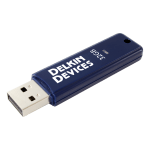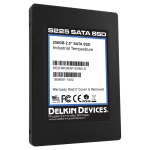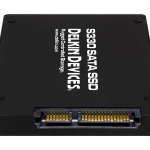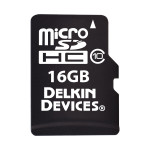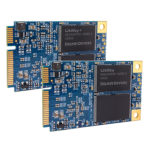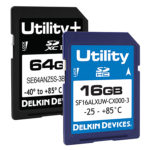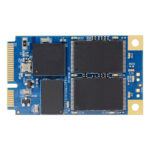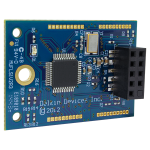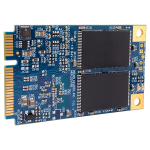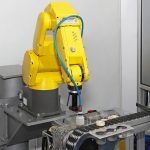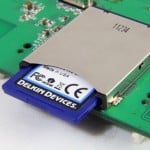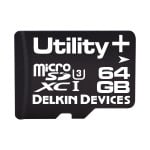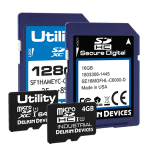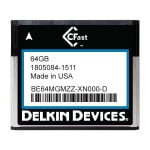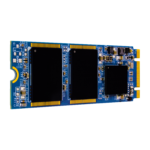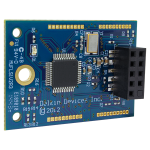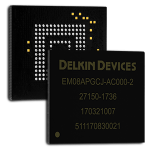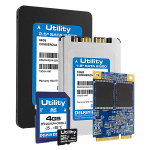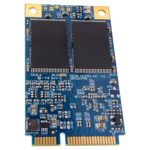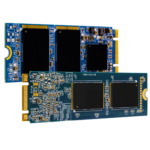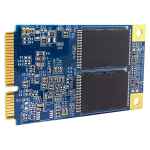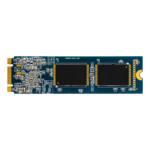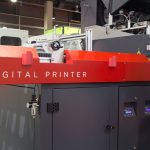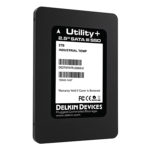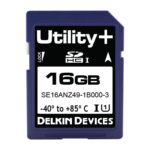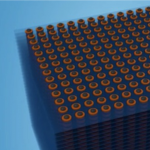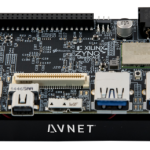Delkin Blog
USB NAND Flash Overview
USB drives may be the most widely recognized storage devices on the market. They are utilized by casual consumers and high-tech industrial users alike. USB flash drives use NAND flash memory chips to store large amounts of data in the confined space of a USB drive. Thanks to NAND flash, surprisingly high storage capacities are available in USB drives, particularly those designed for industrial users whose applications require a large amount of reliable storage. Here is what you need...
Read More
Read More
Get the Facts about Flash Memory Storage Life
One question that comes up time and again when it comes to flash memory is how long it really lasts. The reason for these lingering concerns is understandable but outdated. When it first was introduced to the market, flash memory storage life was short and unpredictable, which is why magnetic storage devices like hard drives were considered to be the preferred technology. However, flash memory has come a significant way since then, and now, it is widely used in...
Read More
Read More
Understanding the Differences Between a Flash SSD Drive and a Hard Drive
Flash SSD drives are quickly becoming the go-to technology in a variety of devices, replacing the once ubiquitous hard disk drive, often called a hard drive or HDD. Despite the explosion in popularity of flash SSD drives, there is still a fair amount of confusion about how these drives differ from each other. Why would a developer design a device with a flash SSD drive instead of a hard disk drive? Although these two types of drives essentially serve...
Read More
Read More
Encryption and Security Development in Solid State Storage Devices (SSD)
General This article will describe the use of Encryption and Security measures in Sold State Drives (SSDs). What is Data Encryption? Data encryption converts data into an unintelligible form, so that it can only be used if converted back to its original form via decryption. Decryption is the reverse process of encryption. Decryption requires access to a secret key ( a decryption key) and an optional password to accomplish this. Encrypted data is commonly referred to as cipher text, while unencrypted...
Read More
Read More
Delkin Devices Holding 12th Annual Toys for Tots Drive
Click here for the article in the San Diego Union Tribune Click here for more information and to donate!
Read More
Read More
A SATA Overview for OEMs
The Serial ATA interface, or SATA, is an interface that connects storage devices and host systems. It was developed as a replacement for PATA and offers many advantages over that previously dominant interface. SATA works with both hard disk drives (HDDs) and solid state drives (SSDs). SATA as been revised multiple times since its inception to keep up with changing technologies, and today, SATA enables applications to take advantage of the speed offered by SSDs, which have become standard...
Read More
Read More
Comparing pSLC and SLC
If you have researched NAND flash storage recently, you may have encountered terms like pSLC and SLC. Understanding what these terms mean and how they differ from each other has an enormous impact on your ability to get the best storage for your application. There are big differences between these kinds of storage, and in fact, the differences between all NAND flash storage formats are significant enough to have a major impact on the functioning of your device. Choosing...
Read More
Read More
Spotlight on 128GB mSATA Features
The introduction of Mini-SATA, or mSATA, to the market in 2009 was a game-changer for devices with small form factors, since it allowed these devices to use the hugely popular SATA interface. mSATA can be found in a huge range of laptops, netbooks, and other mobile devices, thanks to its high data transfer rates, easy compatibility, and business-card size. mSATA is available in a variety of different capacities, with both MLC and SLC NAND flash options, so it is...
Read More
Read More
Industrial SD Card 101
An industrial SD card is a NAND flash-based memory card that are ideal for use in industrial applications that have high demands for endurance and ruggedness. They are easy to add to and remove from host applications as needed, thanks to the widely compatible Secure Digital design. Industrial SD cards are found in a huge variety of industrial applications, since they can easily be used for everything from read-only processes that are common in gaming systems to boot media...
Read More
Read More
SMART Data SSD Reporting: What It Is and How to Read It
SMART data reporting is the key to monitoring the performance of your SSD and pinpointing issues before they cause a critical failure. SMART stands for Self-Monitoring, Analysis, and Reporting Technology, and it is a feature that is incorporated into most SSDs. The trick to using this reporting tool effectively is understanding the data that are being produced and how to interpret them, so you can make the right decisions about your application. There is no single, industry-wide standard used...
Read More
Read More
Answering Questions about 32GB mSATA
mSATA SSDs are a form of solid state drive (SSD) that follows the design specifications created by the SATA International Organization (SATA-IO). This version of the wildly popular SATA SSD interface is smaller in size, so that it can be used in devices which do not have the space for a full-size SSD and for which engineers and OEMs wish to reap the benefits of SATA technology. At about the size of a business card, mSATA can be found...
Read More
Read More
What You Need to Know about High Capacity Flash Drive Options
The demand for ever-increasing amounts of data storage means that the need for a high capacity flash drive continues to increase. The technology for flash drives has advanced dramatically in recent years, and although a flash drive may not offer the same kind of capacity as a solid state drive (SSD) or a hard disk drive (HDD), there are some flash drives available with impressively large storage capacities. These flash drives are not typically designed for the average consumer,...
Read More
Read More
Understanding Embedded Cards
Embedded cards are used in embedded systems to perform specific functions. For example, embedded flash memory cards provide data storage and read and write operations for devices. The user can’t see the embedded card functioning and may not even know it is there, but without it, the device would not perform the tasks it is supposed to do. Embedded cards can perform a wide range of functions, depending on the needs of the host system, and they are vital...
Read More
Read More
Wear Leveling USB Flash Drive Basics
USB flash drives are one of the most widely recognized storage devices for both consumers and technology professionals. They can be easily plugged into a variety of devices that have designated USB ports, and they allow for fast and reliable data transfer and storage. In USB flash drives, one way that data storage is managed efficiently—so that the memory can be used to its full capacity—is with wear leveling. Wear leveling is commonly seen in solid state drives, or...
Read More
Read More
FAQs about the Largest mSATA Drive on the Market
Delkin’s focus is on providing rugged storage solutions for industrial users, so while we offer a variety of high-capacity products that are suitable for a vast number of customers, having the largest mSATA drive on the market has not been our area of focus. However, taking a closer look at the most supersized mSATA drive available is interesting and does help demonstrate how mSATA drives of all sizes function. The largest mSATA drive on the market is the 840...
Read More
Read More
Industrial SATA for Factory Automation
In today’s factory settings, automation is non-negotiable. Plants are adding new automation tools constantly, and embedded flash storage is essential for machine control. To achieve the goals of higher production speeds, reliable automation, and fail-proof data management, many factories are relying on industrial SATA solid state drives (SSDs) to get the job done. Industrial SATA offers the kind of reliability necessary for automation, even in rugged environments like factories where temperature, vibration, and shock levels may be high. Don’t...
Read More
Read More
What Are Industrial Grade Products?
If you’re looking for NAND flash memory products, then you have likely encountered both industrial and consumer grade options. Each of these kinds of products has its place, but choosing the wrong one could lead to serious complications for your application, from device failures to budgetary breakdowns. If you have an industrial application, it’s important to choose an industrial grade product. Failing to do so could cost you a significant amount of time and money in the future as...
Read More
Read More
Questions Answered about Industrial MLC microSD
Industrial MLC microSD cards combine the benefits of MLC microSD technology with features that are usually reserved for SLC-based products. Whether you’re looking for an MLC microSD for a dashboard cam or a high-capacity video system, an industrial grade product will give you the reliability you need. Many customers have questions when selecting an industrial MLC microSD. The answers to these frequently asked questions will help you select the right product for your device. What is an industrial MLC microSD...
Read More
Read More
Secure Digital Card Overview
If you’ve ever looked into options for embedded flash memory, then you are likely to have encountered a Secure Digital card, or SD card. SD is a type of flash memory card that has been on the market since 1999, and thanks to consistent product upgrades and updates, it remains a popular choice for industrial devices that rely on stable, dependable data storage. SD cards are all designed using protocols established by the Secure Digital Association, so users can...
Read More
Read More
SLC vs. MLC Life Span: What You Need to Know
One of the key issues developers and OEMs have to consider when they are choosing SSDs and embedded storage for their applications is life span, and one of the key factors that influences life span is whether the SSD has single-level cell (SLC) or multi-level cell (MLC) storage. Considering the expected life span of an SSD will help developers and OEMs make a selection that fits the demands of their application appropriately, while balancing all other concerns. How does...
Read More
Read More
SSD Reliability Test: How Long Do SSDs Last?
Solid state drives, or SSDs, are becoming as ubiquitous now as hard disk drives, or HDDs, once were. Although many people originally considered them to be cost prohibitive, the pricing structure has changed, making it possible for engineers and OEMs to embrace SSDs for both commercial and industrial grade products. However, the lingering question many people have is not about cost, but longevity. If you’re considering an SSD, you will be relieved to know that these drives last for...
Read More
Read More
Explaining NAND Flash Memory
NAND flash memory is at the core of most embedded storage devices and SSDs. It is a non-volatile form of memory, which means it doesn’t require power to store data, and is considered to be both versatile and reliable. In the past five years, use of NAND flash memory has become widespread in both consumer and industrial applications that need a reliable form of storage that doesn’t require a power source. You can find NAND flash memory in everything...
Read More
Read More
Understanding the Differences Between Commercial Grade and Industrial Grade Memory
If you are shopping for flash storage devices, then you will quickly realize that there is a big distinction between commercial grade and industrial grade embedded storage products. Commercial grade flash memory is what you will find in devices like laptops, cellphones, and cameras. Industrial grade flash memory is found in applications in which data storage is critical and that are used in conditions that would push commercial grade storage past its limits. Here is a closer look at...
Read More
Read More
A Look at the Features of the Industrial Grade CFast Card
An industrial grade CFast card combines the advantages of Compact Flash technology with the SATA interface. For applications that rely on data integrity and need to be up 100% of the time, CFast is an ideal solution, even for challenging embedded environments. The industrial grade CFast card offers extended temperature ranges and a high tolerance for rugged operating conditions, which is why you’ll find it used in healthcare, transportation, aerospace, communications, and other industries in which data loss is...
Read More
Read More
Answers to Frequently Asked Questions about M-2 SSD
M-2 SSDs are designed specifically for use in devices that require a very small form factor and that are power constrained, such as very thin laptops. Originally known as Next-Generation Form Factor, or NGFF, this SSD supports multiple interfaces, including SATA, and delivers higher speeds than older SATA drives. If you are considering using an M-2 SSD in your application, here are the answers to some of the questions that are likely to be on your mind. What makes M-2...
Read More
Read More
Using the Industrial Grade 10-Pin USB DOM
If you have used a desktop, laptop, smartphone, or other computing device in the last decade, there is a good chance you have used a USB port at some point. USB ports are ubiquitous across devices in both the consumer and industrial markets and are designed so that there is a standard way to connect devices to a host system. Although the USB port is often used for external USB connectors, it can also be used for other kinds...
Read More
Read More
What Is eMMC?
eMMC stands for embedded MultiMediaCard. It refers to an embedded technology in which both the flash memory and the flash memory controller are on the same die. This technology was developed as an embedded version of the MultiMediaCard in 1997, and since then, it has been integrated into a wide range of products. Industrial grade eMMC technology is ideal for rugged operating conditions and is widely used, especially in trains, where it must withstand high temperatures, shock, and vibration...
Read More
Read More
Facts about Flash Storage
Flash storage is a form of memory that is found in an enormous array of devices. It is a nonvolatile form of memory, meaning that it can store data even when the system is turned off. This is a huge advantage over DRAM and other forms of volatile data storage. Flash storage uses cells to store data that are written using an electrical charge on cards that are usually embedded in an application. You can find flash storage in...
Read More
Read More
Exploring the Basics of SATA Flash
SATA is the most widely used interface for solid state drives, or SSDs, today. It supports the use of flash memory, which offers much higher operating speeds than HDDs, or hard disk drives. HDDs have increasingly fallen out of favor in recent years, thanks to the increased capacities and improved processing speeds of SSDs, and SATA interfaces have made these transitions possible. SATA flash drives can be found in a huge variety of both consumer and industrial grade products....
Read More
Read More
Understanding CompactFlash Card Durability
CompactFlash is a form of NAND flash memory that is found in a wide array of devices, from point-and-shoot cameras to high level, industrial grade applications. It is one of the most widely recognized and used mass storage devices available, and it has been a favorite with users since it was introduced in 1994. Since that time, CompactFlash cards have of course been updated to keep up with changing technology needs, and today’s versions remain in demand, thanks to...
Read More
Read More
Digital Signage Applications’ Embedded Systems
In the past, digital signage applications have relied on standard PC platforms in order to get the best possible performance. However, embedded systems have improved in leaps and bounds, and now, there are good reasons for designers and end users to pick them over PC platforms. Unfortunately, myths about embedded systems and their effectiveness in digital signage applications persist, and they often prevent digital signage customers from getting the maximum potential from their designs. This is especially problematic for...
Read More
Read More
Electronic Coating 101
The electronic circuit and other components inside your SSDs and flash memory devices are vulnerable to environmental damage. If damage occurs, the device may require a repair or even be rendered completely useless. To protect these systems, a coating is applied. Electronic coating can be completed with conformal coating or encapsulating resin, though conformal coating tends to be more popular. Why do the electronic components need protection? Electronic circuit boards and other components might seem like they are protected, but in...
Read More
Read More
What Is a Ruggedized SSD?
Solid state drives, or SSDs, were once used exclusively for rugged operating conditions. However, the commercial market has now embraced SSDs over hard disk drives, or HDDs. As a result, not all SSDs created today are intended for use in rugged operating conditions. With this in mind, it’s essential for industrial users to ensure that the SSD they are choosing can actually stand up to the environmental demands of their application. This means choosing a ruggedized SSD for the...
Read More
Read More
Answering Questions about NAND Memory Manufacturers
When you’re choosing a NAND industrial flash storage device, the manufacturer is likely to be one of the factors that you consider. Despite the demand for NAND flash storage, there are a surprisingly small number of manufacturers in the business. Each puts its own attention on NAND memory customization options and level of working on solutions for OEMs., so it’s important to choose the right NAND memory manufacturer for your application’s needs. Here are the answers to some of...
Read More
Read More
SLC SATA Basics
SLC SATA is one of the most reliable flash storage options available for industrial applications. This flash-based storage offers unbeatable capacity and data protection, even in rugged operating conditions. SLC SATA can also be customized to provide specific features, including encryption for applications in which data security is a priority. Although SATA was first introduced to the market for consumer applications, it has since been embraced by industrial users for its wide range of benefits. If you are considering...
Read More
Read More
Custom SD Cards Explained
SD cards are a recognized format for storage for a variety of commercial and industrial grade products. One of the many benefits of this form of flash storage is the ease with which it can be customized. Custom SD cards allow designers and OEMs to get device-specific storage that meets their exact needs for everything from formatting to laser etching. The key to getting customized SD cards that fulfill your requirements is to work with a manufacturer who will...
Read More
Read More
How Do Wear Leveling SD Cards Work?
SD cards are a popular choice for industrial grade memory. These NAND flash memory cards are reliable, thanks to their consistent design based on the standards set by the Secure Digital Association, and long-lasting, especially in SLC format. However, one essential algorithm makes wear leveling SD cards last even longer than their original design allows for: wear leveling. Wear leveling algorithms maximize the lifespan of these memory cards by ensuring that blocks of available data storage are used in...
Read More
Read More
FAQs about Flash Based SSDs
Flash based SSDs are ubiquitous in industrial applications. They take advantage of the reliability of flash storage and do away with the moving components found in HDDs, resulting in faster operations and lower risk of data loss. You can find flash based SSDs in a huge array of consumer and industrial grade applications, from laptop computers to complex medical devices. Although there are two kinds of flash memory—NAND and NOR—most storage devices are designed with NAND flash, or a...
Read More
Read More
What Are Embedded Computing Systems?
Embedded computing systems are used every day, yet they are often overlooked and misunderstood. They are essential to the functioning of a huge array of products and applications, from consumer electronics to industrial devices. In fact, the stability of these embedded computing systems is essential to the appropriate functioning of significant aerospace, medical, and communication applications. What exactly are embedded computing systems? Here are the facts you need to know. Embedded computing systems are task-specific. Embedded computing systems are made...
Read More
Read More
Industry Insights: SLC SD for Industrial Multi-function Printers
Industrial multi-function printers offer high-speed functionality in environments that demand flawless performance. For industrial multi-function printers, in addition to performance concerns, there are also sometimes security issues and the need for critical data storage. For this reason, SLC SD cards are frequently found in these kinds of printers. With SLC SD cards for industrial multi-function printers, users get fast performance with the best possible level of reliability and security. Multi-function Printer Basics Multi-function printers are a one-stop-shop for office needs. With one...
Read More
Read More
Technical Success Story: Industrial Storage- Do You Need the Newest Version?
Industrial Flash storage is used in a variety of applications, which means that there has been a significant amount of research into the qualifications, interfaces, and technologies used in the cards. For people who are designing embedded hosts, there is a natural inclination to stay ahead of the curve by using the most advanced technology available. The reason for this is an attempt by designers to ensure that they don’t create host systems that rely on memory cards that...
Read More
Read More
What Are SLC SSD Drives?
If you are in the market for a solid state drive, or SSD, then choosing the right kind of flash memory format is essential. For industrial users, this almost always means choosing SLC SSD drives. SLC SSD drives use the highest grade of flash memory available. This means that OEMs can be confident about their use in industrial applications in which mission-critical data is stored and used. Here are the facts you need to know. Basics of SLC SSD Drives The...
Read More
Read More
Spotlight on SD Card Industrial Grade Features
SD card design is governed by the Secure Digital Association. Although different companies manufacture them, every SD card on the market is designed to meet very specific guidelines set forth by the Secure Digital Association and shared with its members. As such, end users can rest assured that SD cards will always be compatible with their applications, even if they end up ordering cards from a different manufacturer in the future. SD card industrial grade features are designed to...
Read More
Read More
FAQs about 2.5 SSD Industrial Flash Storage
SSDs, or solid state drives, are an alternative to hard disk drives and have made enormous leaps in memory capacity and speeds possible in both commercial and industrial grade devices. A 2.5 SSD is an SSD that is 2.5 inches in size—the most common size for a drive. Although some industrial devices have smaller form factors and need a smaller drive, such as an mSATA-based SSD, the 2.5 SSD is hugely popular and compatible with a wide range of...
Read More
Read More
For Healthcare Data Storage of IoT and AI Info, Consider Flash
Check out this article by Scott Wallask of Search Health IT | Tech Target on why professionals working with healthcare data storage should consider Flash storage. Click below to read the full article: With IoT and AI-driven data growing in healthcare organizations, a consultant suggests providers look into flash storage to take advantage of the technology’s speed... ...
Read More
Read More
What Are Secure Digital Card Specifications?
Secure Digital cards, or SD cards, are a specific type of non-volatile storage that was developed by the Secure Digital Association, or SDA. SD cards are manufactured by a number of different companies, but the SDA issues strict guidelines that dictate the features that the cards must have and how they must be designed and constructed. Secure Digital card specifications exist to ensure that OEMs and developers who use SD cards in their devices know exactly what they are...
Read More
Read More
3D NAND Flash Explained
Although NAND flash storage is the leading storage format used in solid state drives, or SSDs, there is one concern that has long worried engineers and OEMs—its size. NAND flash storage devices have to be small, but they also have to be powerful. In some instances, capacity has been limited by the need to keep the device as small as possible. Fortunately, a solution has been found: 3D NAND flash. This format uses space on NAND flash storage cards...
Read More
Read More
SATA vs. NVMe
The ever-increasing use of data has resulted in an ever-increasing demand for faster data transfer rates. The speed of data transfer is largely controlled by the interface used by the drive. With more and more systems using SSDs—solid state drives—rather than HDDs, or hard disk drives, the data transfer rate of the interface is more important than ever. While HDDs seldom reach peak data transfer speed capacity, SSDs can, as long as the interface can support the speed that...
Read More
Read More
What You Need to Know about SATA Data Transfer Rate
SATA is one of the most widely used interfaces in modern technology. It’s virtually impossible to have used a desktop or laptop computer over the past decade that did not have a piece of SATA hardware inside. When it comes to both solid state drives (SSDs) and hard disk drives (HDDs), SATA interfaces are often a critical component, and the SATA data transfer rate is an important factor to consider. SATA interfaces are common in both commercial and industrial...
Read More
Read More
Delkin 16GB Industrial microSD Card on Ultra96 Development Board
Delkin is proud to feature a 16 GB MicroSD card on the Ultra96™development board. Applications of the board include artificial intelligence, machine learning, and IoT/cloud connectivity for add-on sensors. CLICK HERE TO CHECK IT OUT! ...
Read More
Read More
 Login
Login Register
Register


